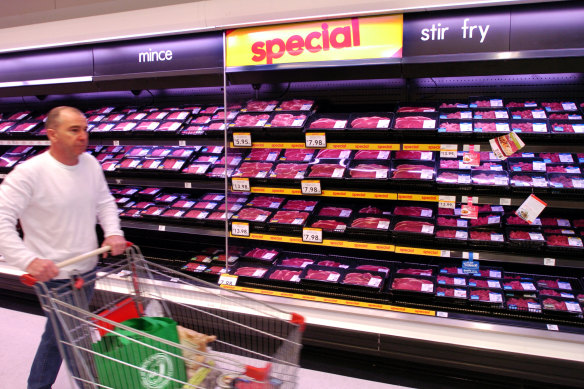Save articles for later
Add articles to your saved list and come back to them any time.
Supermarket prices for red meat are not falling as fast as plummeting livestock markets, which slid so much over the past year that some farmers are giving away their sheep for free, sparking calls for greater supply chain transparency and an inquiry into major retailers.
The cattle price fell an average of 66 per cent across the eastern seaboard in the past year, and lamb prices are down 38 per cent, due to a glut of livestock as farmers offload animals ahead of a potential drought-ridden summer.
Supermarkets have been slow to respond to plummeting livestock prices. Credit: Sean Davey
Farmers are asking why their low returns haven’t resulted in similar savings for shoppers, with lamb cutlets now selling for about $43 a kilogram at supermarkets and rump steak $28 a kilogram.
Former Australian Competition and Consumer Commission chairman Alan Fels said retailers and other businesses in the retail supply chain were too slow to pass on low livestock prices, potentially shortchanging consumers, and called for a major inquiry.
“Red meat prices should, but do not, reflect the fall in prices for farmers. This is of special concern at a time of deep cost-of-living pressures,” said Fels, who has been commissioned by Australian Unions to conduct a price-gouging inquiry.
“We need to look into the people in the middle, between the farmers and the consumers – that is: processors, retailers and others. Businesses are systematically slow to pass on price falls and quick to find excuses.
“We need transparency, and an ACCC inquiry would shine a light where required and expose any profiteering.”
Prices have started to come down at the supermarket. Analyst NielsenIQ Homescan recorded an 8 per cent fall in retail beef and a 15 per cent slide in lamb prices over the past four weeks.
Cost of living is front-of-mind for shoppers and governments, with the Australian Bureau of Statistics reporting on Wednesday that inflation in the September quarter lifted by a larger-than-expected 1.2 per cent, driven by the cost of petrol, the tight rental market and increasingly expensive insurance.
Rural Bank senior agricultural analyst Michael Curtis said that while retailers had been slow to lower meat prices, the same scenario had played out in reverse in 2021 and 2022, when retailers had been slow to raise their prices in response to record high livestock prices.
“Retail prices didn’t follow the livestock markets up, when cattle prices rose nearly 150 per cent from 2019 to 2022 and retail prices only rose about 23 per cent, so it’s kind of understandable that they wouldn’t match the decline,” Curtis said.
“What we’ve seen this year is the cattle market come back down to where the retail level was, and now it probably has gone below that level if you index them against each other.”
Meat and Livestock Australia is the red meat industry’s statutory marketing and research organisation. Its information and insights manager, Scott Cameron, said farmers were constantly asking him why their low prices are not being passed through the middlemen to shoppers.
Cameron said it typically took eight months for livestock prices to flow through the supply chain, through meat processors and onto supermarket shelves.
“The reasons for that lag are the production schedule from producing to transforming the animal into the cut, the rump steak, the sausage,” he said.
“There is also the fact that a lot of retailers buy on forward contracts, which locks a price in for around six months ahead of the market trend, which means that they might be buying at a higher price.”
Woolworths Group chief executive Brad Banducci said on a call with media last week that he expected meat prices to continue to fall, pointing to lamb legs that are now selling for $10 a kilogram – the lowest price since 2018.
A spokesperson for Coles said it had dropped meat prices and expected that trend to continue, including for its most popular meat product, a kilogram of beef mince, which fell from $13 in March to $11 in September.
Start the day with a summary of the day’s most important and interesting stories, analysis and insights. Sign up for our Morning Edition newsletter.
Most Viewed in Politics
From our partners
Source: Read Full Article








